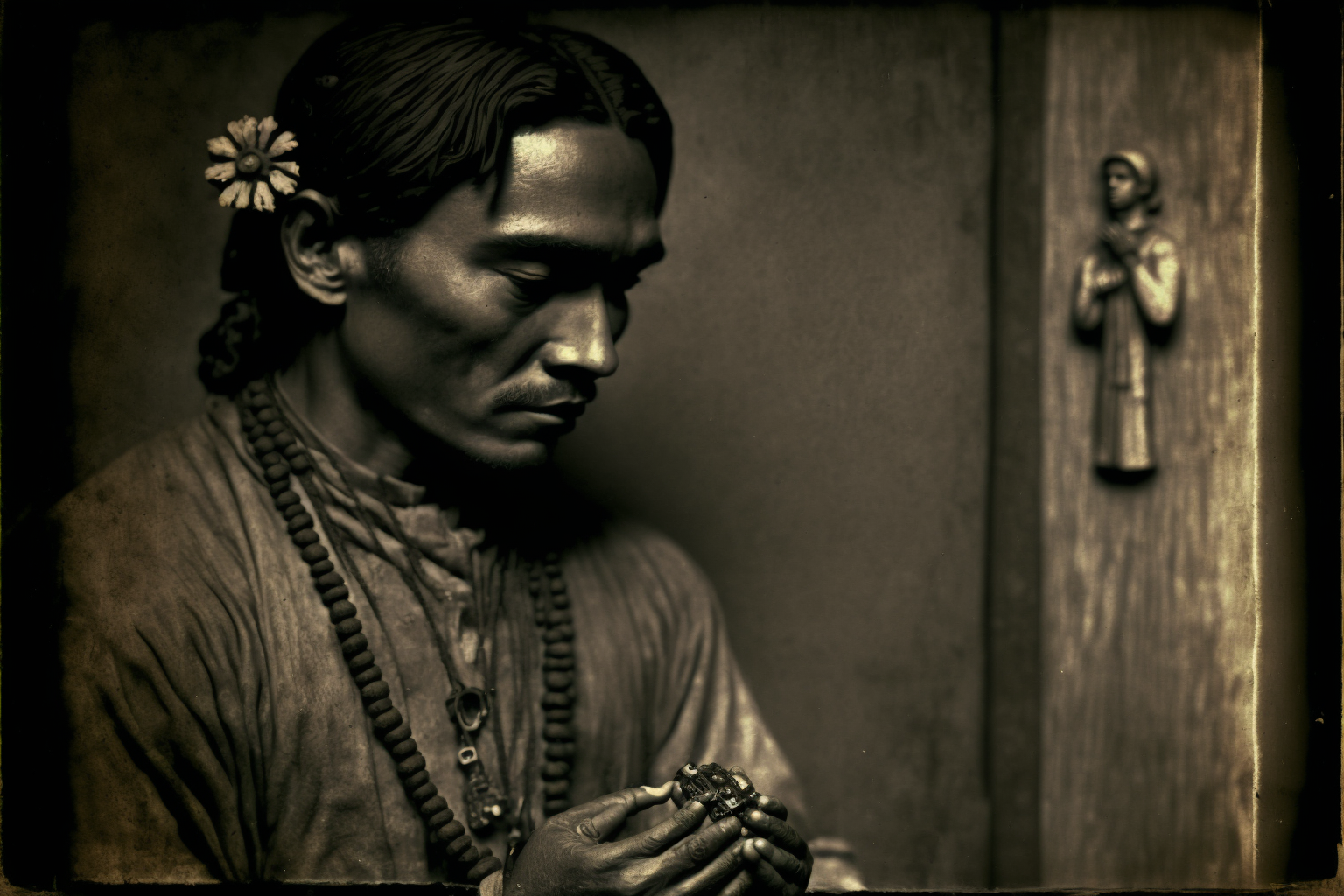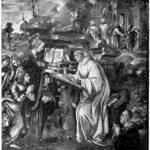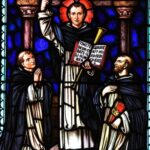
St. Lorenzo Ruiz
St. Lorenzo Ruiz
When they lived:
St. Lorenzo Ruiz, a remarkable figure in the annals of history, lived during the late 16th and early 17th centuries. He was born around 1600 in Binondo, Manila, which was then part of the Spanish Philippines.
Where they lived:
Lorenzo Ruiz’s life unfolded against the backdrop of Manila, a bustling city that was part of the vast Spanish colonial empire in Asia. His early years were marked by the intertwining of cultures and influences, as the Philippines became a melting pot of various civilizations.
Notable world events during the time of their life:
- Kepler’s Laws of Planetary Motion (early 17th century): As Lorenzo Ruiz navigated the challenges of his life, the scientific world was undergoing a revolution. Johannes Kepler’s formulation of the laws governing planetary motion reshaped humanity’s understanding of the cosmos, opening new avenues of inquiry into the nature of the universe.
- The Thirty Years’ War (1618-1648): This devastating conflict engulfed Europe and had far-reaching consequences, reshaping political boundaries and altering the course of history. While Lorenzo Ruiz’s world was distant from the war’s epicenter, it symbolized the turbulence and uncertainty of the times.
- The Taj Mahal Construction (1632-1653): While St. Lorenzo Ruiz’s life was marked by personal trials, on the other side of the world, the construction of the iconic Taj Mahal was underway. This architectural marvel stands as a testament to the creative genius and cultural richness of the Mughal Empire in India.
- Galileo’s Trial (1632): In a momentous clash between science and religion, Galileo Galilei faced trial for advocating the heliocentric model of the solar system, challenging prevailing religious dogma. This event mirrored the tensions and debates that Lorenzo Ruiz may have witnessed within his own Catholic faith.
Patronage:
St. Lorenzo Ruiz, canonized as the first Filipino saint and known as the “Protomartyr of the Philippines,” is revered as the patron saint of a variety of causes. His patronage extends to:
- Filipino migrants and overseas workers: Lorenzo Ruiz’s own journey as a missionary and martyr resonates with the struggles and challenges faced by modern Filipino migrants seeking a better life abroad.
- Martyrs: St. Lorenzo Ruiz’s willingness to sacrifice his life for his faith has made him a symbol of courage and devotion for all those who have endured persecution and hardship due to their beliefs.
- The Philippines: As a figure deeply rooted in the country’s history, Lorenzo Ruiz serves as a reminder of the enduring Filipino spirit and resilience.
The Remarkable: Martyrdom and Canonization
As we trace the footprints of Lorenzo’s life, we find ourselves on the precipice of his most remarkable, poignant act – his martyrdom. The gleaming heart of his tale lies not in his birth, but rather in his extraordinary death and the profound faith that underpinned it.
On the cold, cruel execution grounds of Nagasaki, Lorenzo’s faith was tested. The echoes of his profound declaration at his trial, ring loud and clear, a stark testament to his undying faith. “I am a Catholic and wholeheartedly do accept death for God. Had I a thousand lives, all these to Him shall I offer.” His voice, firm against the cacophony of his accusers, radiates a defiance that resonates through the annals of time. Lorenzo’s brave commitment to his faith in the face of death continues to reverberate across the centuries, shaping the narratives of courage and faith.
But Lorenzo’s story does not end with his martyrdom. Rather, it ascends to a new realm, one of reverence and devotion, as his tale reaches the Vatican. The canonization of Lorenzo by Pope John Paul II on October 18, 1987, marks an epochal event. Here, an ordinary Filipino layman ascends to sainthood, becoming the first Filipino saint. His life – a story woven by humble beginnings, embroidered with sacrifice, and culminated in eternal honor – paints a vibrant picture of faith, courage, and resilience.
The radiant core of Lorenzo’s martyrdom is the transformation of an ordinary man into an extraordinary saint. His tale resonates with the powerful reminder that sainthood is not the exclusive domain of the clergy or the mystics, but can also be the destiny of ordinary individuals living lives of extraordinary faith and commitment.
As we unravel this tale further, we step back into the past, into the dawn of Lorenzo’s life, to understand how the seed of such unwavering faith was sown and nurtured. So, let us journey to the cobblestone streets of 17th century Manila, where the tale of our Patron Saint begins…
Early Life and Faith Formation
Delving into the dawn of Lorenzo’s life, we find ourselves amidst the hustle and bustle of 17th century Manila, where our tale begins. Amid the thrumming life of this vibrant city, a child named Lorenzo Ruiz was born around the year 1600, his life as yet untouched by the extraordinary destiny that awaited him.
Raised in the historic district of Binondo, Lorenzo’s early life was woven into the fabric of a devout Catholic community. His parents, firm in their faith, nurtured Lorenzo in the warm cradle of Catholicism. The whisperings of prayers, the chiming of church bells, and the hallowed rituals of the faith were the rhythms that defined his childhood.
Education, for young Lorenzo, was an affair of faith and learning. Taken under the wing of Dominican friars, he was educated at the Convent of Santo Domingo. These hallowed halls, teeming with knowledge and devotion, shaped his early understanding of faith and spirituality. Here, serving as an altar boy, he discovered a sanctuary, a space where his faith could blossom.
Yet, Lorenzo was not just a man of faith, but also a man of family. As he grew, he embraced the mantle of husband and father, wedding Rosario, a native woman, and fathering three children. His family, his domestic life, added layers to his faith, giving it depth and texture. Faith, for Lorenzo, was not merely practiced in the quiet solitude of the church but also lived amidst the clamor of family life, tested and proven in the crucible of daily living.
This background, both humble and richly textured, laid the foundation for the journey Lorenzo was yet to embark upon. The ordinary life he led in Manila was soon to take an extraordinary turn, steering him toward an unexpected path, an unforeseen destiny. The road to martyrdom and sainthood was yet unseen but imminent, its first steps paved in the heart of Binondo and the Convent of Santo Domingo. As we tread further, we find Lorenzo sailing into the unknown, a journey that would inscribe his name in the annals of faith forever…
The Journey to Martyrdom
The winds of fate are capricious and unpredictable, and for Lorenzo, they carried him far from the familiar streets of Manila, to a land where faith was a crime and belief, a death sentence. His journey from the Philippines to Japan was not one of pilgrimage or mission but an unexpected twist of destiny, fueled by the need to escape a dubious accusation.
The year was 1636, and Lorenzo found himself a wanted man, implicated in a crime he did not commit. With danger looming over his head, he took the fateful decision to flee aboard a ship, unknowingly setting a course towards his extraordinary destiny. The ship carried him to Okinawa and then to Japan, lands where the shadows of persecution loomed ominously over the Christian faith.
Japan, under the rule of the Tokugawa shogunate, was a furnace of Christian persecution. The once flourishing Christian community was under the crushing weight of religious oppression. Believers were driven underground, their faith a clandestine whisper amidst the deafening roar of oppression. Into this treacherous landscape stepped Lorenzo, unknowingly trading one danger for another.
In the spring of 1637, Lorenzo, along with his companions, found themselves ensnared in the grip of the Tokugawa shogunate. Arrested in Osaka and transported to Nagasaki, the stage was set for a trial that would test their faith to its limits.
The trial of Lorenzo and his companions was not a quest for justice but a brutal gauntlet designed to shatter their faith. Subjected to the torment of the ‘water torture,’ they were hung upside down over a pit, the world inverted as they clung to their beliefs. Yet, Lorenzo’s faith remained unbroken. His response to his torturers would echo through the ages, a testament to an indomitable spirit: “I am a Catholic and wholeheartedly do accept death for God. Had I a thousand lives, all these to Him shall I offer.”
In the face of brutal torture and the promise of death, Lorenzo held steadfast, embodying the extraordinary strength and resilience of faith. His path to martyrdom was paved not in defeat but in the triumphant affirmation of his beliefs. Yet, Lorenzo’s tale does not end with his death but lives on in the enduring legacy he left behind…
The Legacy of St. Lorenzo Ruiz
The legacy of Lorenzo Ruiz is not carved in stone, rather it lives, breathes, and thrives in the hearts of the faithful. His life, his sacrifice, and his unyielding faith cast a long, influential shadow, reaching far beyond the execution grounds of Nagasaki, across oceans and centuries, to touch millions of lives.
In the devout corners of the Philippines, in the quiet reverence of churches and the fervor of family prayers, the spirit of Lorenzo is vibrantly alive. As the Patron Saint of the Philippines and of Overseas Filipino Workers, he embodies the strength, resilience, and deep-seated faith of the Filipino people. The celebration of his feast day on September 28th brings forth a tidal wave of devotion and remembrance, sweeping across the Philippines and reaching every corner of the globe where Filipinos have set foot.
His influence extends beyond the boundaries of his homeland. Lorenzo’s tale has etched itself into the broader narrative of Christianity, a vibrant testament to the power of unwavering faith and the ultimate sacrifice. He stands as a reminder that the roots of faith can hold firm even in the harshest storms of persecution.
Modern-day Christianity, in its quest for role models of faith and perseverance, often finds itself returning to the story of Lorenzo Ruiz. His narrative is invoked in sermons, explored in theological discussions, and reflected upon in personal contemplation. Lorenzo’s life presents enduring lessons of courage in the face of adversity, commitment to faith, and sacrifice for one’s beliefs.
The humble layman from Manila, the dutiful server at Santo Domingo convent, the devoted husband and father, the brave martyr of Nagasaki, and the first canonized Filipino saint, Lorenzo Ruiz continues to inspire, his life a beacon of faith in a world in desperate need of hope and strength.
As we bring this exploration to a close, we look back at Lorenzo’s remarkable journey, a testament to an ordinary life imbued with extraordinary faith and commitment, inspiring us to reflect on our own paths and the power of unwavering faith…
Conclusion
As we conclude our exploration into the extraordinary life of Lorenzo Ruiz, we find ourselves not at an end, but at a beginning. The tale of Lorenzo, the humble man from Manila who became a beacon of faith and courage, is more than a historical account. It is an invitation – a call to contemplate the depth of our own faith and the strength of our convictions.
In his life, we see the remarkable transformation of an ordinary individual into a figure of extraordinary faith and courage. We witness the journey of a man who held steadfast to his beliefs even when faced with the ultimate test. Lorenzo Ruiz, in his martyrdom, became a testament to the power of faith and the strength of the human spirit.
In his story, we are reminded that extraordinary courage and faith are not the exclusive domain of the clergy or the mystically inclined. They can be found in the most ordinary of lives, waiting to be awakened by extraordinary circumstances. We are reminded that our faith, like Lorenzo’s, can stand the test of adversity, and in doing so, becomes a source of inspiration for others.
St. Lorenzo Ruiz, a name whispered with reverence, a story told with admiration, a legacy that continues to inspire, is more than just the Patron Saint of the Philippines. He is a testament to the resilience of faith, the courage of the ordinary individual, and the potential for extraordinary transformation that resides within each one of us.
As we step away from the tale of St. Lorenzo Ruiz, we carry with us the echoes of his indomitable spirit, his unwavering faith, and his unflinching courage. May his life story continue to inspire us, to guide us in our moments of trial, and to remind us of the extraordinary power of faith in the face of adversity.
In the words of Lorenzo himself, “Had I a thousand lives, all these to Him shall I offer.” With these words resonating in our hearts, let’s celebrate the life, the courage, and the enduring legacy of St. Lorenzo Ruiz.
Five Interesting Facts About St. Lorenzo Ruiz
- St. Lorenzo Ruiz is the first Filipino saint and protomartyr to be canonized.
- The beatification of St. Lorenzo Ruiz by Pope John Paul II on February 18, 1981, was held in Manila. This was the first beatification ceremony ever held outside the Vatican!
- St. Lorenzo Ruiz is the patron saint of Filipino youth, the Philippines, people working overseas, and altar servers.
- When he was offered to recant his faith and be spared, St. Lorenzo Ruiz told his interrogators, “Had I many thousands of lives, I would offer them all for him. Never shall I apostatize. You may kill me if that is what you want. To die for God, such is my will.”
- The major church dedicated in honor of St. Lorenzo Ruiz is the Minor Basilica and National Shrine of Saint Lorenzo Ruiz, formerly known as Our Lady of the Most Holy Rosary Parish, in his hometown of Binondo, Manila.
Prayer to St. Lorenzo Ruiz
O most merciful and almighty God, You bestowed as a gift to Lorenzo Ruiz The strength to withstand the overpowering forces of death For the sake of his faith in You. Through his prayers,Help us to follow his example by overcoming all life’s trials and eventually increasing our hope and love for You. St. Lorenzo Ruiz, you brought honor to your country, having been a level-headed and prudent father of the family and a witness of Christ in your life until your death.
We present all our petitions to God through your help so that, by our actions, We may know more and love more Jesus, our Lord and Savior. We humbly implore your intercession, dear St. Lorenzo, for the infinite glory of God and in honor of your triumph as a martyr of Christ and defender of Christianity. Amen.



